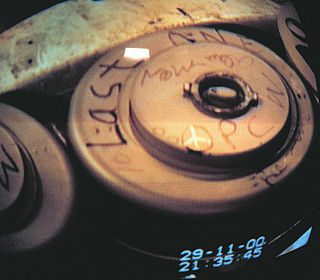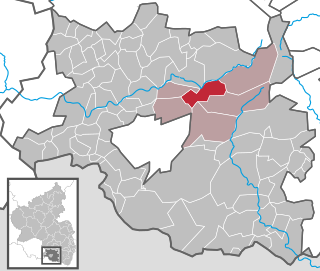
Operation Steel Box, also known as Operation Golden Python (German name for the transport in Germany: Aktion Lindwurm), was a 1990 joint U.S.-West German operation which moved over 100,000 U.S. chemical weapons from Germany to Johnston Atoll.

Operation Steel Box, also known as Operation Golden Python (German name for the transport in Germany: Aktion Lindwurm), was a 1990 joint U.S.-West German operation which moved over 100,000 U.S. chemical weapons from Germany to Johnston Atoll.
At a United States Army Site near Clausen, West Germany 100,000 GB and VX filled American chemical munitions were stored in 15 concrete bunkers. [1] These munitions were managed by the 330th Ordnance Company (EOD) and guarded by the 110th Military Police Company both headquartered in nearby Münchweiler an der Rodalb. The propellants for these munitions were stored in Leimen Site 67. The GB and VX munitions had undergone a refurbishment from 1980 to 1982. The weapons in this depot were scheduled to be moved due to an agreement between the United States and West Germany. The 1986 agreement, between Ronald Reagan and Helmut Kohl, provided for the removal of 155 mm and 8 inch unitary chemical projectiles. [2]
The program sponsor, the Military Sealift Command, brought in the prestigious naval architecture firm, George G. Sharp, inc of New York City as project manager to oversee the design-development efforts to modify and outfit the two crane ships for the mission and assigned former Electric Boat submarine engineer Jim Ruggieri, P.E. as project engineer. The vessels were outfitted with a collective protection system – or a positive pressure system used to pressurize the house relative to the cargo hold as a means of preventing inadvertent weapon gas migration in the event of a containment failure; manned Laboratories – to provide a safe and comfortable environment to scientists to perform analyses of the products; unmanned “sniffer” and alarming modules to sample cargo hold air to detect containment failures, as well as detect and alarm positive pressure system failure; power generation modules to supplement ship power and emergency power provisions, and specialized communications modules to permit coordination with security forces.
Operation Steel Box began on July 26, 1990 and ended on September 22, 1990, [3] but the weapons did not reach their final destination until November. [1] [4] The move from the storage facility to an intermediate facility at Miesau utilized trucks and trains, civilian contractors, and U.S. and West German military personnel. [2] The weapons were repacked and shipped by truck from their storage facility until they reached the railway in Miesau. [1] The truck transport portion of the mission involved 28 road convoys which delivered the munitions the 30 miles from Clausen to Miesau. [4]

The munitions were carried by special ammunition train from Miesau to the port of Nordenham. The train transport was well publicized and escorted by 80 U.S. and West German military and police vehicles. [1] At the port the munitions were loaded onto two modified ships, the SS Gopher State and the SS Flickertail State, [2] by the Army's Technical Escort Unit. [1] The ships were operated by the U.S. Military Sealift Command, [2] and upon leaving Nordenham they sailed for 46 straight days. [1] [2] The ships arrived at Johnston Atoll and on November 18 unloaded the last of their cargo containers. [1]
Security and emergency response were both concerns during Steel Box. Besides the police and military escort for the trains, the road convoys had restricted airspace overhead. [1] Along the route, emergency response teams were on stand-by. [1] While the ships were in port U.S. Navy EOD Detachments provided underwater hull sweeps to ensure limpet mines were not attached to the ships. The 46-day trip at sea was non-stop, with refueling taking place along the route. [2] The ships were also escorted by the U.S. Navy guided missile cruiser USS Bainbridge and USS Truxtun. [2] The transport ships avoided the Panama Canal, for security reasons, [1] and took the route around Cape Horn, the tip of South America. [2] There were no reported chemical agent leaks or security breaches during the transport phase of Steel Box. [2]
The 1990 shipments of nerve agents from Germany to the Johnston Atoll Chemical Agent Disposal System facility caused several South Pacific nations to express unease. [2] At the 1990 South Pacific Forum in Vanuatu, the island nations of the South Pacific indicated that their concern was that the South Pacific would become a toxic waste dumping ground. [5] Other concerns raised included the security of the shipments, which were refueled at sea and escorted by U.S. guided missile destroyers, while they were en route to Johnston Atoll. [2] In Australia, Prime Minister Bob Hawke drew criticism from some of these island nations for his support of the chemical weapons destruction at Johnston Atoll. [6]

Johnston Atoll is an unincorporated territory of the United States, currently administered by the United States Fish and Wildlife Service (USFWS). Johnston Atoll is a National Wildlife Refuge and part of the Pacific Remote Islands Marine National Monument. It is closed to public entry, and limited access for management needs is only granted by Letter of Authorization from the United States Air Force and a Special Use Permit from the U.S. Fish and Wildlife Service.

Chemical warfare (CW) involves using the toxic properties of chemical substances as weapons. This type of warfare is distinct from nuclear warfare, biological warfare and radiological warfare, which together make up CBRN, the military acronym for chemical, biological, radiological, and nuclear, all of which are considered "weapons of mass destruction" (WMDs), a term that contrasts with conventional weapons.

Bomb disposal is an explosives engineering profession using the process by which hazardous explosive devices are rendered safe. Bomb disposal is an all-encompassing term to describe the separate, but interrelated functions in the military fields of explosive ordnance disposal (EOD) and improvised explosive device disposal (IEDD), and the public safety roles of public safety bomb disposal (PSBD) and the bomb squad.

The Umatilla Chemical Depot (UMCD), based in Umatilla, Oregon, was a U.S. Army installation in the United States that stored chemical weapons. The chemical weapons originally stored at the depot consisted of various live munitions and storage containers each holding 1 short ton GB or VX nerve agents or HD blister agent. All munitions had been safely destroyed by 2011 and base closure operations were still ongoing as of 2022.

The United States Army Chemical Materials Activity (CMA) is a separate reporting activity of the United States Army Materiel Command (AMC). Its role is to enhance national security by securely storing the remaining U.S. chemical warfare materiel stockpiles, while protecting the work force, the public and the environment to the maximum extent.

The Pine Bluff Arsenal is a United States Army installation in Jefferson County, Arkansas, about eight miles northwest of Pine Bluff and thirty miles southeast of Little Rock.
Operation Red Hat was a United States Department of Defense movement of chemical warfare munitions from Okinawa, Japan to Johnston Atoll in the North Pacific Ocean, which occurred in 1971.

Beginning in the mid-1930s, Japan conducted numerous attempts to acquire and develop weapons of mass destruction. The 1943 Battle of Changde saw Japanese use of both bioweapons and chemical weapons, and the Japanese conducted a serious, though futile, nuclear weapon program.

The M23 is a United States steel cased chemical landmine. The mine was developed in the late 1950s and early 1960s, and approximately 100,000 units were produced. The U.S. completed its destruction of its stock at the Umatilla Chemical Depot in 2008 and the Johnston Atoll Chemical Agent Disposal System in 2000.

Clausen is a municipality in Südwestpfalz district, in Rhineland-Palatinate, western Germany. Clausen belongs to the local association community of Rodalben.

Münchweiler an der Rodalb is a municipality in Südwestpfalz district, in Rhineland-Palatinate, Germany, and belongs to the municipal association of Rodalben. The primary industry of the village was that of a shoe manufacturer. It lies on Strasse B-10 between Karlsruhe and Pirmasens.
Husterhoeh Kaserne was a military facility in Pirmasens, Rhineland-Palatinate, Germany. Kaserne is a German loanword that means "barracks." It was a United States military base 1945–1994. Since then it is a German base, most of which has closed. The base still has some US military operations and German military storage.

Johnston Atoll Chemical Agent Disposal System (JACADS) was the U.S. Army's first chemical munitions disposal facility. It was located on Johnston Island, at Johnston Atoll and completed its mission and ceased operation in 2000.

The M55 rocket was a chemical weapon developed by the United States in the 1950s. The United States Army produced both Sarin and VX unitary warheads for the M55.
Throughout history, chemical weapons have been used as strategic weaponry to devastate the enemy in times of war. After the mass destruction created by WWI and WWII, chemical weapons have been considered to be inhumane by most nations, and governments and organizations have undertaken to locate and destroy existing chemical weapons. However, not all nations have been willing to cooperate with disclosing or demilitarizing their inventory of chemical weapons. Since the start of the worldwide efforts to destroy all existing chemical weapons, some nations and terrorist organizations have used and threatened the use of chemical weapons to leverage their position in conflict. A notable example includes the use of such weapons by the US government that sprayed more than 20 million gallons of various herbicides over Vietnam, Cambodia and Laos from 1961 to 1971. Agent Orange, which contained the deadly chemical dioxin, was the most commonly used herbicide. Other examples of the use of chemical weapons are Iraq’s Saddam Hussein on the Kurdish village Halabja in 1988 and their employment against civilian passengers of the Tokyo subway by Aum Shinrikyo in 1995. The efforts made by the United States and other chemical weapon destruction agencies intend to prevent such use, but this is a difficult and ongoing effort. Aside from the difficulties of cooperation and locating chemical weapons, the methods to destroy the weapons and to do this safely are also a challenge.
The 11th Panzergrenadier Division was a West German mechanized infantry formation. It was part of the I Corps of the Bundeswehr. I Corps was part of NATO's Northern Army Group (NORTHAG), along with the I Belgian Corps, I British Corps, and the I Netherlands Corps. In the wake of military restructuring brought about by the end of the Cold War, the 11th Panzergrenadier Division was disbanded in 1994.

The 267th Chemical Company was a military unit of the U.S. Army Chemical Corps responsible for the surety of chemical warfare agents dubbed "RED HAT" deployed to the Islands of Okinawa, Japan and subsequently Johnston Atoll in the Pacific Ocean. A recently discovered Army document reveals that the true mission of the 267th Chemical Company was the operation of the Okinawa deployment site as part Project 112. Project 112 was a 1960s biological warfare field test program that was conducted by the Deseret Test Center. Okinawa is not listed as a test site under Project 112 by the U.S. Department of Defense.
The United States chemical weapons program began in 1917 during World War I with the creation of the U.S. Army's Gas Service Section and ended 73 years later in 1990 with the country's practical adoption of the Chemical Weapons Convention. Destruction of stockpiled chemical weapons began in 1985 and is still ongoing. The U.S. Army Medical Research Institute of Chemical Defense (USAMRICD), at Aberdeen Proving Ground, Maryland, continues to operate.